We unleash your business potential by maximize the business innovation.
Send EmailTungsten Trioxide, Tungsten Oxide, Dioxotungsten, Tungstic Anhydride, 1314‑35‑8
Tungsten trioxide (CAS 1314‑35‑8):
📑 Quick Facts
-
CAS No: 1314‑35‑8
-
Chemical Formula: WO₃
-
Molecular Weight: 231.84 g/mol
-
Density: ~7.16 g/cm³
-
Melting Point: ~1473 °C
-
Packaging Types: 25 kg bags, drums, IBCs
-
HS Code: 2825.90 (metal oxides, tungsten compounds)
⚙️ Technical Properties
-
Appearance: Yellow crystalline powder (can appear greenish depending on hydration state)
-
Solubility: Insoluble in water, soluble in alkalis and acids
-
Crystal Structure: Monoclinic (stable at room temperature), polymorphic transitions at high temperature
-
Purity Grades: 99.0–99.99% (industrial vs. high‑purity grades)
🏭 Applications
-
Metallurgy: Intermediate for tungsten metal and tungsten carbide production
-
Pigments: Yellow coloration in ceramics and glass
-
Electrochromic Devices: Smart windows, displays (WO₃ thin films change color under voltage)
-
Catalysis: Used in petrochemical and environmental catalysts
-
Electronics: Gas sensors, optical coatings, photocatalysis
🔬 Production Methods / Sources
-
Obtained by calcination of ammonium paratungstate (APT)
-
Thermal decomposition of tungstic acid or tungsten salts
-
High‑purity WO₃ produced via controlled crystallization and purification
📊 Sector Suitability Table
| Sector | Suitability | Notes |
|---|---|---|
| Metallurgy | ✔ | Precursor for tungsten metal/carbide |
| Ceramics & Glass | ✔ | Pigment, optical coloration |
| Electrochromics | ✔ | Smart windows, thin‑film devices |
| Catalysis | ✔ | Petrochemical/environmental catalysts |
| Food/Cosmetics | ✖ | Heavy metal oxide, not permitted |
🧾 Other Names
-
Tungsten(VI) oxide
-
Tungstic anhydride
-
Dioxotungsten(VI)
-
WO₃
🛡️ Safety & MSDS Summary
-
GHS Pictograms: ⚠️ Irritant, 🌍 Environmentally hazardous
-
Storage: Dry, sealed packaging, avoid moisture
-
PPE: Gloves, goggles, dust mask/respirator
-
Waste: Collect as heavy metal oxide waste, dispose via licensed facilities
🌍 Market & Commercial Information
-
Purity Grades: 99%, 99.9%, 99.99%
-
Packaging: 25 kg bags, 50 kg drums, 1000 kg IBCs
-
Producer Regions: China, Austria, USA (major tungsten refiners)
-
Trade Names: Tungstic oxide, WO₃
🧪 Quality & Analytical Data
-
Tests: ICP‑OES (trace metals), XRD (phase), BET (surface area), particle size distribution
-
Forms: Powder, nanopowder, thin‑film precursors
🌱 Environmental & Sustainability Aspects
-
Waste Management: Classified as heavy metal oxide; requires controlled disposal
-
Recycling: Recoverable from tungsten scrap and spent catalysts
-
Carbon Footprint: Moderate; depends on mining and refining of tungsten ores
